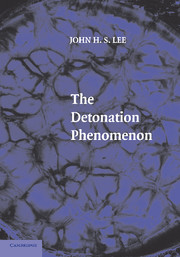Book contents
- Frontmatter
- Contents
- Preface
- 1 INTRODUCTION
- 2 GASDYNAMIC THEORY OF DETONATIONS AND DEFLAGRATIONS
- 3 DYNAMICS OF DETONATION PRODUCTS
- 4 LAMINAR STRUCTURE OF DETONATIONS
- 5 UNSTABLE DETONATIONS: NUMERICAL DESCRIPTION
- 6 UNSTABLE DETONATIONS: EXPERIMENTAL OBSERVATIONS
- 7 INFLUENCE OF BOUNDARY CONDITIONS
- 8 DEFLAGRATION-TO-DETONATION TRANSITION
- 9 DIRECT INITIATION OF DETONATIONS
- Epilogue
- Index
5 - UNSTABLE DETONATIONS: NUMERICAL DESCRIPTION
Published online by Cambridge University Press: 06 July 2010
- Frontmatter
- Contents
- Preface
- 1 INTRODUCTION
- 2 GASDYNAMIC THEORY OF DETONATIONS AND DEFLAGRATIONS
- 3 DYNAMICS OF DETONATION PRODUCTS
- 4 LAMINAR STRUCTURE OF DETONATIONS
- 5 UNSTABLE DETONATIONS: NUMERICAL DESCRIPTION
- 6 UNSTABLE DETONATIONS: EXPERIMENTAL OBSERVATIONS
- 7 INFLUENCE OF BOUNDARY CONDITIONS
- 8 DEFLAGRATION-TO-DETONATION TRANSITION
- 9 DIRECT INITIATION OF DETONATIONS
- Epilogue
- Index
Summary
INTRODUCTION
Self-propagating one-dimensional ZND detonations are unstable and hence not observed experimentally in general. However, a solution for the laminar structure of a ZND detonation can always be obtained from the steady one-dimensional conservation equations, irrespective of the activation energy, which controls the temperature sensitivity and thus the stability of the detonation. The use of the steady one-dimensional conservation equations excludes any time-dependent multidimensional solution that describes the instability of the detonation wave. The classical method of investigating the stability of a steady solution is to impose small multidimensional perturbations on the solution and see if the amplitude of the perturbations grows. The assumption of small perturbations permits the perturbed equations to be linearized and integrated, and thus the unstable modes to be determined. As with most hydrodynamic stability analyses, the dispersion relation is rather involved and cannot be expressed analytically, which obscures the physical basis of the stability mechanism.
An alternative method is to start with the time-dependent, nonlinear, reactive Euler equations and then integrate them numerically for given initial conditions. Stability is indicated when a steady ZND solution is achieved asymptotically at large times. Unlike linear stability analyses, direct numerical simulations have the advantage that the full nonlinearity of the problem is retained. Furthermore, stability in one, two, and three dimensions can be separately investigated, which facilitates the interpretation of the numerical results. Current numerical techniques and modern computers can readily handle the integration of the multidimensional, time-dependent, reactive Euler equations.
- Type
- Chapter
- Information
- The Detonation Phenomenon , pp. 98 - 146Publisher: Cambridge University PressPrint publication year: 2008



